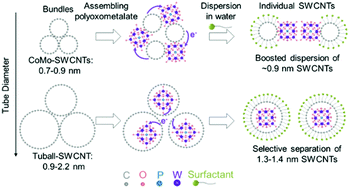Selective separation of single-walled carbon nanotubes in aqueous solution by assembling redox nanoclusters†
Abstract
The selective separation of soluble and individual single-walled carbon nanotubes (SWCNTs) in aqueous solution is a key step for harnessing the extraordinary properties of these materials. Manipulating the strong van der Waals intertube interactions between the SWCNT bundles is very important in selective separation, which is a long-standing challenge. Here we reported the ability of redox polyoxometalate clusters to modulate the intertube π–π stacking interaction through electron transfer and achieved the diameter-selective separation of SWCNTs in a surfactant aqueous solution. The large-diameter SWCNTs concentrated at ∼1.3–1.4 nm were selectively separated when ∼1 nm clusters encapsulated within the tube cavity, and the dispersion of subnanometer ∼0.7–0.9 nm SWCNTs was boosted when clusters were adsorbed on the outer surface of small-diameter nanotubes. The mechanism of diameter-selective separation of SWCNTs associated with the size-dependent interaction between cluster-tubes and the steric hindrance effect of clusters was revealed by optical absorption and Raman spectroscopy. This simple method thus enables the selective separation of individual high-quality SWCNTs in aqueous solutions without harsh sonication with the potential for other separation applications.



 Please wait while we load your content...
Please wait while we load your content...